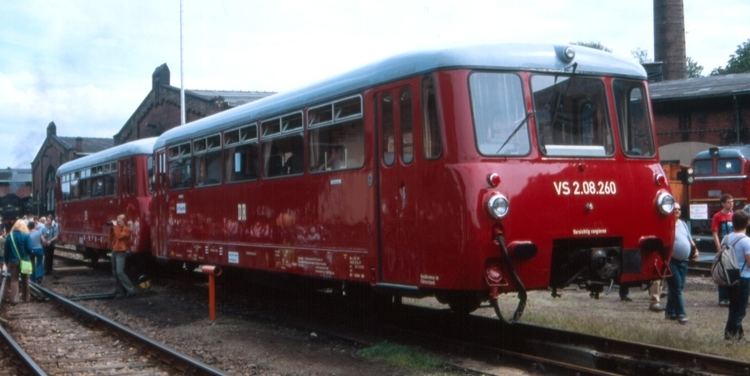Manufacturer Waggonbau Bautzen | Wheel diameter 900 mm (35.43 in) | |
 | ||
Constructed 1957 (pilot series),
1962 – 1969 Operator(s) Deutsche Reichsbahn
Deutsche Bahn Car length 13.55 m (44 ft 5 ⁄2 in) Wheelbase 6,000 mm (19 ft 8 ⁄4 in) | ||
DR class VT 2.09 were light railcars of Deutsche Reichsbahn in the GDR. They were designed and built by Waggonbau Bautzen. In 1970 they were renumbered into classes 171/172, and in 1992 into classes 771/772.
Contents
History
In order to replace pre-war railcars and steam-hauled passenger trains on branch lines, Waggonbau Bautzen started designing a new series of light railcars started in 1955 and completed the first two prototypes in 1959. One of them had a Büssing engine, the other one from Dieselmotorenwerk Berlin-Johannisthal. They entered regular service in 1962. In the same year, six more railcars with trailers were built, and in 1963 sixteen more railcars and for the first time some driving trailers, too. Further vehicles were built by Waggonbau Görlitz.
The original classification as VT 2.09 refers to the general type of vehicle (VT = Verbrennungstriebwagen = railcar with internal combustion engine), the power output (approximately 1/100 of the engine power, measured in PS) and the top speed (approximately 1/10 of the value in km/h). The trailers were numbered as VB 2.08, the driving trailers as VS 2.07.
The series had multiple nicknames, among them Ferkeltaxe ("piglet taxi") due to it being commonly used on rural lines, or Blutblase ("bloody blister") because of their original dark red paint. After repainting, the name Pfefferminzbonbon ("peppermint candy") could be heard.
After Deutsche Reichsbahn and Deutsche Bundesbahn pooled their rolling stock in 1992, accompanied by a renumbering of the DR fleet, many members of this class were rebuilt and repainted into the mint green - white scheme of the regional trains. After new railcars became available, classes 771/772 were withdrawn from service in 2000. 22 vehicles were sold to Cuba and Romania, others to Spain and Brazil. The last railcar of class 772 was retired from regular service in Stendal in Januar 2004.
Technical details
Powered cars had two cabs that were originally open to the interior, driving trailers had only one. The folding doors could be closed remotely and had warning bells and lights. The six-cylinder engines of type 6 KVD 18 SIHRW, built by Elbewerk Roßlau and nearly identical to those used in the shunting locomotives of DR Class V 15, were mounted beneath the floor. The last, Görlitz-built series was equipped with the new version 6KVD 18/15-1 HRW of this engine, specially modified for use in the railcars. The power was transmitted over a hydraulic drive, followed by an electro-mechanical gearbox to one axle. A pneumatically operated axle-mounted reverse gearbox allowed directional control. The electrical systems of the powered car were supplied by a 24 V / 1.2 kW alternator, those of the trailers by generators which were driven from the axle by a belt. The latter proved insufficient so that the powered cars were later equipped with two alternators working in parallel. Thermostat-controlled heating was provided by oil-fired radiators, in the powered cars also by the engine cooling water.
The first members of the class had curved windows reaching around the corners of the cabs. For easier manufacturing, later vehicles were eqipped with flat glass windows overall, and have pillars in the cab corners.
Starting 1965, the later series (which became class 172) were equipped with multiple-unit train control, so that trains consisting of up to 6 cars could be run. To avoid damage by the buffers of other rolling stock, auxiliary rubber buffers were fitted at the appropriate height.
Re-building in the early 1990s involved the installation of train radios, PZB cab signalling, new driver's consoles, an electronic timetable system (EBuLa), and rear walls with lockable doors for the cabs. The interior was refurbished according to the then prevailing taste, the number of available seats dropped from 54 to 40. New engines of MAN type 2866 UH with 162 kW power were installed, some of the electro-mechanical gearboxes were replaced with Voith Diwa D863 hydraulic gearboxes of a type used in buses. Some driving trailers were motorised, and two powered cars that were used on the lines on Usedom island were converted to use natural gas as engine fuel.
Operation
The railcars were intended for branch line services and could be seen almost all over the GDR, except on lines with steep gradients. Due to their top speed of 90 km/h they were also be used in stopping train services on mainlines, in particular north of Berlin. Furthermore, the saw regular use on suburban services around Berlin and Leipzig, and on staff trains.
Preservation
Several railcars and trailers have been preserved for excursion trains, among them
